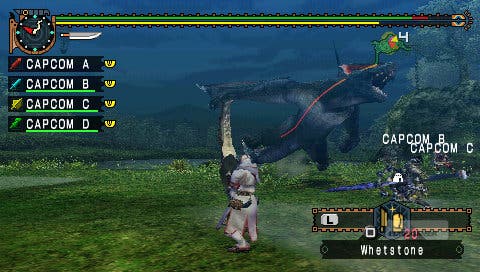Monster Hunter Freedom Unite
Stalking point.
These materials are then combined in pairs, sometimes through several stages, to create increasingly powerful doohickeys. The addition of a farm, on which many non-monster materials can be gathered between quests, takes a lot of the grind out of the experience, but in order to remain prepared you'll be doing a lot of gathering, scouring each area for ingredients during almost every mission. If you're coming home from a mission with room in your inventory, then you're probably wasting your time.
This process of collecting and combining, mirrored in the creation of weapons and armour, is the bread and butter of the monster-hunting experience. There are no XP, so equipment is the only way to improve your stats and increase your chances. Many of the materials required for powerful kit are rare drops, some found as little as four or five per cent of the time when "carving" a dead Wyvern. This means that you'll be fighting the same monsters a lot, repeating quests in search of that elusive shell or scale to compete an armour set.
This farming becomes a large part of the mid-game, when the limits of your skill are likely to wash up against a cliff of difficulty surmountable only via statistics. It's surprisingly non-repetitive, however. Each monster is unpredictable enough, a formidable enough challenge, to keep each hunt interesting.
There's a great deal of skill involved in the actual fighting; combat is a nuanced and delicate business. Feints and dodges must be combined with attacks of opportunity, monster attack patterns must be studied, memorised and adapted to. Knowing when to turn tail and run is incredibly important.
The first foes I encounter, the raptor-like Velocipreys and their Velocidrome leader, are fast and agile, easily evading the clumsy blows of my slow Great Sword (I only find out later that's it's regarded as a "pro's choice"). Initially I'm frustrated by the seemingly interminable periods when my hunter stands nonplussed in the snow after a chop, seven-foot blade embedded in the permafrost, whilst I'm gently reduced to ribbons by a pack of bright blue dinosaurs.

This is a game of unskippable animation sequences, punishing dead zones and gratingly unnecessary victory poses for actions as routine as drinking a potion. Many of the enemies you'll face are, despite their increasingly vast size, very quick indeed. Trying to heal, eat, or sharpen your weapon in combat means studying attack patterns and finding just the right gap to fit in the action before you're punished.
It's a long process, but when it clicks - realising that you need to dodge more than block, that timing is everything - it quickly becomes incredibly satisfying. Before long I'm nonchalantly cutting swathes through hordes of bipedal lizards, but soon I overreach myself against a mushroom-munching jungle ape and all of the frustration returns. I'm too slow again, both my strategy and tactics are flawed. I'm crushed.
Progress is a repetition of this process. Whilst there's always a healthy selection of missions to choose from, there'll usually be a monster who's a sticking point in each batch as they're unlocked: a particular fiend whose style completely confounds yours, who's just too fast or too powerful. This means going back to the drawing board - rethinking your approach and farming an easier foe to pick up the necessary bits for a new breastplate.

This is how the game stays fresh, despite the fact that you'll be exploring the same areas and fighting the same beasts a lot: it's always you who needs to improve. As important as equipment is, grinding isn't a process of gathering experience points - it's a process of improving your skills.
One of the small concessions that Capcom has made to sanity in this version is the addition of a Felyne companion when soloing. Previously, one big problem with soloing was aggro. Fighting a Wyvern and its cohorts alone meant that all attention was focused on you, and getting respite involved fleeing. Having a Felyne along takes away some of this pressure, distracting monsters long enough to use recovery items or prepare an attack. They're also one of the best examples of the incongruous yet welcome humour to be found in the game - a slightly kooky and off-kilter insouciance which gives the gloom of constant battle just the right dash of levity.









